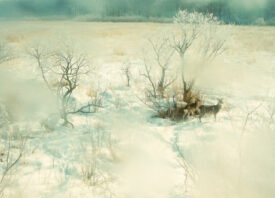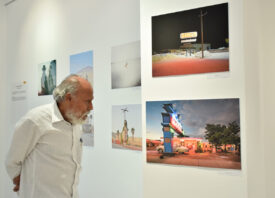Search this site
Announcing the Feature Shoot Exhibition at the Indian Photo Festival 2022


We’re thrilled to announce the five photographers selected by Feature Shoot’s Founder, Alison Zavos, to be part of our group exhibition in Hyderabad as part of the Indian Photo Festival, now entering its eighth edition. The winning work was made across five continents–the United States, Asia, Africa, Australia, and Europe, using a variety of formats and media, making for a show that feels at once global and deeply personal.
While there is no fixed theme for the show, all five winners explore, in one way or another, the meaning of home. In Japan, Takeshi Suga captures moments of nostalgia and magic, as told through the twinkling play of light across winter landscapes. Meanwhile, Oana Bakovic creates a surreal, hallucinogenic dreamscape using plants found throughout Britain.
Traveling across the sun-baked Sahel desert in Niger, Terri Gold witnesses joy and reverie in the celebrations of the nomadic Wodaabe people. Barton Lewis captures a different kind of landscape altogether, discovering a hidden world of abstract images and found artwork, tucked away in the corners of the streets of New York.
Not all of these stories are celebratory. In Australia, Matthew Dunne tells the haunting story of the deliberate killing of hundreds of Wedge-Tailed Eagles. For that reason, the exhibition is also tinged with loss and mourning, with Dunne’s work serving as a reminder of the fragility of our planet and the irrevocable scars we inflict on our landscapes–the same places we call home.

Each of these five photographers was hand-selected from among Feature Shoot’s premium newsletter subscribers, who support the work we do every day. You can see the show in person in Hyderabad this fall, with the international festival running from November 18th to December 19th. Visit the IPF website for information on upcoming exhibitions, talks, workshops, and more. Read more about the winners below.

Winter Wonderland is Takeshi Suga’s exploration of nature in Japan; made on film, the photographs transport us to the borderland between dreams and reality. “Through the sequence of imagery, I seek to convey that the idea of a ‘winter wonderland,’ which was formed in the west, can also be applied to Japanese winter landscapes,” Suga writes.
“Winter in some parts of Japan can be extremely harsh with heavy snowfall and fewer hours of sunlight than any other season, but these images of landscapes state that becalmed beauty and wonder do exist in the moments of euphoric serenity the season also offers every now and then – that is where I believe Winter Wonderland resides.”

In Desert Days, Oana Bakovic uses ambient light, flash, filters, and color grading to transform floral scenes into alien terrain. “The air was burning; bees and birds were knackered, while the flowers and plants seemed to melt into each other, displaying fragments of a paranoid world,” the artist writes.
“My imagination took me on a wild journey to the theatrical dualities in this fantastic world. The stories and the intrigues, the music and the dance, the love and the drama, the loss and the hope. This collection features an eclectic amalgam of native and far away flowers and plants co-existing in Britain.”

From 2015 to 2017, John Auer and Murray James Silvester poisoned and killed 406 Wedge-Tailed Eagles in Tubbut, Victoria. The Killing Sink is the photographer Matthew Dunne’s exploration of that crime and its implications. “Despite the image of Australia as home to unique and wonderful animals, we have some of the worst rates of extinction in the world,” the artist says.
“Since colonialisation, 90 Australian species have gone extinct, and Australia has lost more biodiversity in the last 200 years than any other nation on Earth. Far from slowing, this trend is continuing to accelerate even today. The Killing Sink is a photographic/research project that examines the killing of one species, Wedge-Tailed Eagles, to tell a broader story about the environment.”

In sublime infrared, Terri Gold tells a story of family, community, and tradition in the desert. “In the Sahel desert in Niger and Chad, the nomadic Wodaabe spend months apart, searching out pastures for their herds and shelter for their families,” she says. “When the rains are good, the clans celebrate with an extraordinary courtship ritual and beauty contest called The Gerewol, and it’s the men who are on parade.
“The sweltering desert region of Niger seems an unlikely place to be so concerned with beauty yet it is an integral part of the Wodaabe culture. They display their beauty as a spiritual act, full of dignity and honor. Each person is an artist, and they are their art–a living canvas. The intensity rises as they dance all night in their technicolor dreamcoats, a surreal line-dance.”

“The exterior walls of buildings and construction fences serve as billboards for brands and canvases for street artists in New York City,” the photographer Barton Lewis writes. In Urban Topographies, he follows in the footsteps of Walker Evans and Aaron Siskind, whose pictures of a torn movie poster and textured walls, respectively, helped set the stage for this modern-day photographic survey.
“Brands plaster ads across these surfaces in a form of guerilla marketing known as ‘wild posting’ or ‘wheat pasting,’” Lewis continues. “Street artists tear them to create collages, and the organic processes of decay further transform them into arresting images. My photographs capture these surfaces at a moment in time, belying their continuous evolution and fleeting existence, as posters decay and fences are dismantled.”
While Feature Shoot is free to read, one way to support us is through our paid newsletter, which includes exclusive articles, content, and opportunities. If you sign up for a yearly subscription ($99/year), you’ll also receive a free portfolio review with our Founder and Editor-in-Chief, Alison Zavos. Subscribe now.



